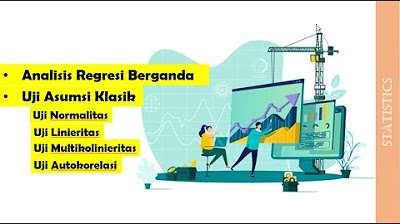Week 6 Statistika Industri II - Analisis Regresi (part 1)
Summary
TLDRThis video discusses simple linear regression, building on the previous topic of correlation. It explains the distinction between correlation and regression, emphasizing that regression determines the impact of one variable (X) on another (Y). The formula for linear regression is introduced, showcasing how it captures data patterns using probabilistic models. The video also touches on the concept of errors in predictions and the importance of estimating parameters accurately through methods like least squares. Lastly, it highlights the assumptions required for regression analysis and prepares viewers for future explorations of hypothesis testing in regression models.
Takeaways
- 😀 Understanding the evolution of neuroscience can enhance educational practices.
- 📚 Neuroscience informs effective teaching strategies based on how the brain learns.
- 💡 Brain plasticity highlights the importance of creating adaptive learning environments.
- 🔍 Research shows that emotional well-being significantly affects cognitive performance.
- 🧠 Active learning techniques promote deeper engagement and retention of information.
- 👩🏫 Educators should be aware of different learning styles to cater to diverse student needs.
- 📝 Assessment methods should align with neuroscience principles for more accurate evaluations.
- 🌐 Collaborative learning fosters social connections and enhances cognitive development.
- 🏆 Real-world applications of neuroscience can drive innovative curriculum design.
- 🚀 Continuous professional development for educators is crucial for implementing neuroscience insights.
Q & A
What is linear regression?
-Linear regression is a statistical method used to model the relationship between a dependent variable (Y) and one or more independent variables (X) by fitting a linear equation to observed data.
How does linear regression differ from correlation?
-While correlation measures the strength and direction of a relationship between two variables, linear regression specifically examines how one variable (the independent variable) affects another variable (the dependent variable).
What is meant by 'dependent' and 'independent' variables in regression?
-In a regression model, the dependent variable (Y) is the outcome that is being predicted or explained, while independent variables (X) are the predictors that influence the dependent variable.
What does the regression equation Y = a + bX represent?
-In this equation, Y is the dependent variable, a is the intercept (the value of Y when X is zero), b is the slope of the line (indicating how much Y changes for a unit change in X), and X is the independent variable.
What is a deterministic model?
-A deterministic model is one where the output is precisely determined by the input values, with no random elements involved. It provides definite predictions for given inputs.
What is a probabilistic model?
-A probabilistic model incorporates randomness and uncertainty, acknowledging that even with the same input, the output can vary due to inherent variability in the data.
What is the significance of error in regression analysis?
-Error in regression refers to the difference between the observed values and the values predicted by the model. Understanding error helps in assessing the model's accuracy and in making adjustments.
What assumptions must be met for regression analysis?
-Key assumptions include that the residuals (errors) are normally distributed, that they have constant variance (homoscedasticity), and that they are independent of each other.
How do we estimate the coefficients in a linear regression model?
-Coefficients in linear regression are estimated using methods such as the least squares method, which minimizes the sum of the squares of the errors between observed and predicted values.
What is the importance of using software for regression analysis?
-Using software for regression analysis simplifies complex calculations, provides statistical outputs quickly, and allows for easier visualization and interpretation of data.
Outlines

This section is available to paid users only. Please upgrade to access this part.
Upgrade NowMindmap

This section is available to paid users only. Please upgrade to access this part.
Upgrade NowKeywords

This section is available to paid users only. Please upgrade to access this part.
Upgrade NowHighlights

This section is available to paid users only. Please upgrade to access this part.
Upgrade NowTranscripts

This section is available to paid users only. Please upgrade to access this part.
Upgrade NowBrowse More Related Video

(1/4) Analisis Regresi : Uji asumsi Klasik

Analisis Korelasi "Nilai Koefisien Korelasi dan Tingkat Korelasi" Part 1 Mtk 11 SMA Kmerdeka

Data Mining 09 - Korelasi & Analisa Regresi (1/2)

Simple Linear Regression Concept | Statistics Tutorial #32 | MarinStatsLectures

Modul 12 (StatSos2) - Konsep Dasar Regresi Linear Sederhana

[Mathematics in the Modern World] Correlation & Simple Linear Regression
5.0 / 5 (0 votes)